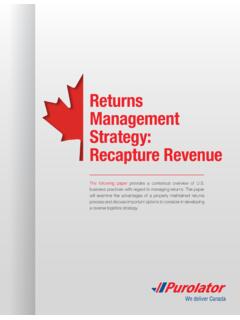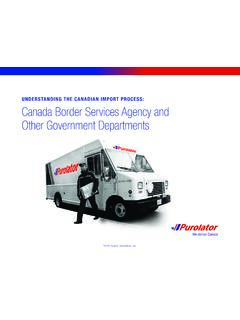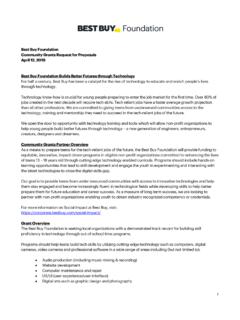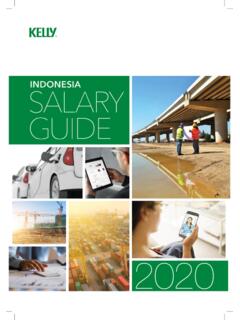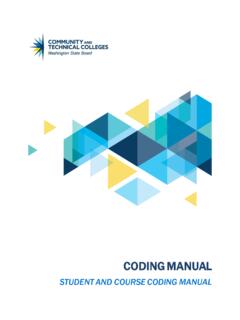Transcription of LOGISTICS MANAGEMENT BEST PRACTICES
1 LOGISTICS MANAGEMENT BEST PRACTICESAll for Superior Customer Service2 LOGISTICS MANAGEMENT plays a significant role in the success of any company s operations and has a direct impact on its bottom line. More importantly, LOGISTICS processes play a big part in customer satisfaction, which is more important than low product costs. LOGISTICS professionals should think of themselves as a customer-facing portion of the company and strive every day to add value for their customers. The Council of Supply Chain MANAGEMENT defines LOGISTICS MANAGEMENT as: .. that part of supply chain MANAGEMENT that plans, implements and controls the efficient, effective forward and reverse flow and storage of goods, services and related information between the point of origin and the point of consumption in order to meet customers requirements.
2 LOGISTICS MANAGEMENT is often confused with supply chain MANAGEMENT . Supply chain MANAGEMENT has broader objectives and actually encompasses LOGISTICS MANAGEMENT . Supply chain MANAGEMENT (SCM) includes inter-enterprise, multi-functional processes that target everything from the supplier s inbound freight to the end consumer. LOGISTICS MANAGEMENT (LM) is the more practical, hands-on part of the supply chain where goods are transported into a facility, properly stored, handled and transported out. LM focuses on short-term procedures and SCM is focused on the long-term. In this whitepaper, you will learn about the development and focal points of LOGISTICS MANAGEMENT , difficulties companies have within these focal points and the best PRACTICES to achieve optimized LOGISTICS , which leads to superior customer service.
3 Making quick, informed decisions can save a company up to 40% on LOGISTICS costs, so one of the best PRACTICES in LM is to implement a fine-tuned LOGISTICS strategy. Since the supply chain is constantly changing, so are LOGISTICS processes. Developing and implementing a formal LOGISTICS strategy will add flexibility to the decision making process and increase error-response time. A deliberate strategy will let a company predict service disruptions and know how and when to respond to them to ensure service levels stay at peak does a company implement a LOGISTICS MANAGEMENT strategy? First, assess all LOGISTICS functions. Take a look at every part of the organization s LOGISTICS MANAGEMENT and define how it should work and how it contributes to overall supply chain MANAGEMENT goals.
4 Look at each physical part of the LOGISTICS process and determine its optimum function; LOGISTICS STRATEGY40%can be saved on LOGISTICS costs by making quick, informed are distribution centers in the right locations and are there enough of them?Even after a strategy is applied, continue to evaluate its success and ask if there are other opportunities. The entire supply chain environment is continually evolving, so LOGISTICS roles must be flexible. To design a new strategy or analyze your existing LOGISTICS processes, ask and answer these 8 questions: Do you have a way to handle expedited shipping differently than slower moving shipments? Would it be beneficial to do so? Is there a plan that defines when an item should be inventoried and when an item should be sent directly to a customer?
5 Would it be more effective to have a third party LOGISTICS (3PL) company manage some or all aspects of your LOGISTICS functions? What financial and service considerations must you take into account before making this decision? Can your distribution network be improved? Could a change of carrier or mode save money or improve service in outbound transportation? Do you carry too much inventory? Too little? What are your specific customer service goals? Is it easy item returns? Delivery speed? Safety? What future business operations will affect LOGISTICS functions and are you prepared to handle them?For every business, there are different LOGISTICS needs and different ways to evaluate operational success.
6 A static LOGISTICS strategy will cause serious harm to customer service and the bottom line. It s detrimental to not benchmark success or direction for improvement. While the LOGISTICS environment changes frequently, and the amount of data available for analysis grows, you have to actively strategize in order to stay ahead of the fluctuations to avoid disorder. The only way to do this is to ask questions about your LOGISTICS processes, evaluate successes and inefficiencies, and alter your LOGISTICS MANAGEMENT strategy to fit your company s changing LOGISTICS is one of the most overlooked aspects in LOGISTICS MANAGEMENT . On average, companies can potentially save between 20 58% on inbound freight spend.
7 Most companies focus on outbound LOGISTICS as this is a low-hanging fruit. There are usually more pressing matters for a business to attend to, and many lack any control over inbound freight. However, to drive significant INBOUND LOGISTICSA LOGISTICS STRATEGY must be evaluated regularly to find new opportunities4savings and improve customer service, it is critical to gain control of inbound LOGISTICS . FREIGHT PAID TO FREIGHT COLLECTThis is a simple change most companies can effortlessly implement. Freight Paid is a common payment method for inbound freight among shippers. Freight Paid means that the supplier pays for transportation costs. A switch to Freight Collect is advantageous; this is where the consignee pays for freight cost.
8 It might sound counterintuitive, but it s important to keep in mind that the company who immediately pays a carrier is not necessarily the party ultimately responsible for the cost of transportation. Switching to Freight Collect will give your company control over inbound LOGISTICS . Often, the true cost of transportation is hidden in the price of a product, between 4 and 7% of the total cost. With control over inbound freight, you know exact transportation costs and can streamline the truck s route by having it drive straight to your distribution center, not making an extra stop at the supplier s distribution Collect is a best practice in LOGISTICS MANAGEMENT because this method will give you visibility into the inbound process.
9 Visibility makes identifying inefficiencies and implementing change possible. With visibility, a company can analyze carrier performance, track overall costs, predict and avoid disruptions, and analyze vendor performance. Then, choose the best combination to save money and time; these benefits will be seen by your customer through improved COMPLIANCE PROGRAMSA lot of companies don t pay attention to inbound freight, and even fewer see the necessity of a vendor compliance program (VCP). These companies are missing out on potential profits, streamlined LOGISTICS functions and improved customer service, among many other benefits. A good VCP can be a competitive proper VCP will define expectations and benchmarks for the vendor, have a way of tracking and reporting vendor performance, include frequent meetings to discuss any necessary changes, and ensure all consignee goals are consistently reasons to have a vendor compliance program: Current LOGISTICS Environment: LOGISTICS processes are more and more complicated every year.
10 This means that there are more opportunities for errors than ever before, and in today s world, errors disrupt the supply chain. Every point of the LOGISTICS process is dependent on each 20-58%can be saved on inbound freight spend5other, and the entire LOGISTICS process is just one point of the overall supply chain. Any inefficiencies or minor slip up in inbound freight MANAGEMENT affects the internal process, the customer, and even the end-consumer. Technology: Technology became very important in transportation and LOGISTICS after the recession, when transportation departments downsized. Since then, the available technology has grown and improved significantly. Today s software can measure and analyze just about anything, giving you a good chance of success at any LOGISTICS venture.
